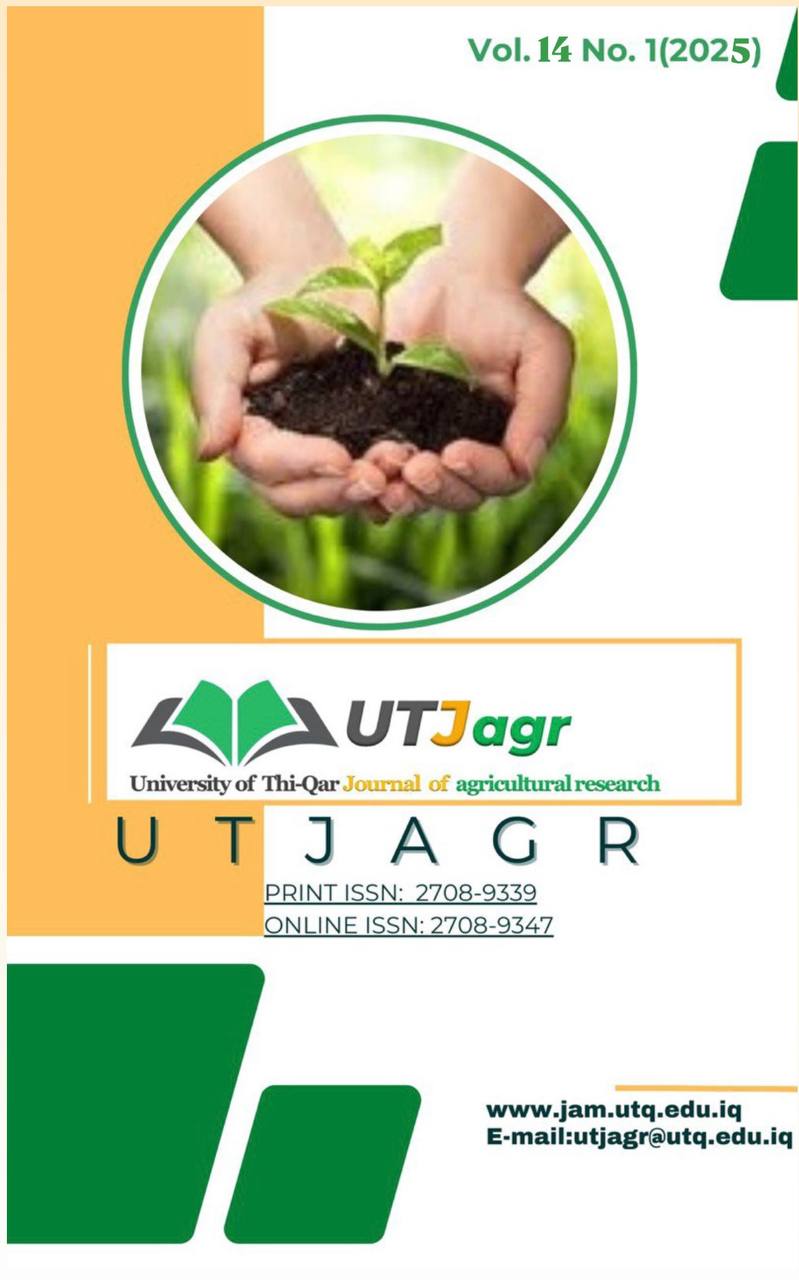The Synergistic Impact of IL-10 Gene Polymorphisms and Epidemiological Variables on Brucellosis-Induced Abortion in Ewes
DOI:
https://doi.org/10.54174/dywvnv12Keywords:
Abortion, ewe, IL-10, polymorphism, brucellosis.Abstract
The present study sought to ascertain the correlation between genetic polymorphisms of the IL-10 gene and abortion in aborted ewes, utilizing a sample size of 100 (75 aborted ewes and 25 pregnant ewes as a control group). The current study indicated that age may influence the risk of brucellosis; ewes were categorized into three age groups, with the 5-7 year age group exhibiting a considerable rise in brucellosis cases (35 out of 48 cases; 72.9%). The high incidence of brucellosis in the first age group (1-4 years) accounted for 17 out of 23 cases, representing 73.9%. In the age bracket of 8-9 years, 13 out of 48 cases (27.1%) exhibited a reduction in abortions. The findings of this study demonstrate a significant correlation between the gestational stage and the etiology of abortion. Conversely, abortion cases occurring in the first and second trimesters were ascribed to factors unrelated to Brucella melitensis. During that period, a direct sequencing method was employed for the analyzed PCR amplicons. Subsequently, the identified variations were positioned according to their locations within the corresponding genomic DNA sequences. The current results demonstrated the presence of the 117 C>G, 118 G>C polymorphisms, and C-del 256 of the IL-10 gene. The current findings indicate a non-significant connection (p value: 0.09204) between the 117C>G and 118G>C polymorphisms of the IL-10 gene polymorphisms and abortion in aborted ewes.
Downloads
References
Al-Dabagh, I., Jasim, B., & Jarjees, M., (2014). Seroprevalence of antibodies to toxoplasmosis, brucellosis and chlamydiosis in abortive sheep in Nineveh governorate, Iraq. Iraqi Journal of Veterinary Sciences, 28(1), 21-25. doi: 10.33899/ijvs.2014.89467
Ahmed, W., Zheng, K., Liu, Z. F. (2016). Establishment of chronic infection: Brucella’s stealth strategy. Frontiers in Cellular and Infection Microbiology, 6, 30.
Corbel MJ; Food and Agriculture Organization of the United Nations;World Health Organization; World Organisation for Animal Health.,)2006(. Brucellosis in humans and animals. Geneva: World Health Organization.; [updated 2006; cited WHO/CDS/EPR/2006.7]. Availablefrom: https://apps.who.int/iris/handle/10665/43597
Carson A .,(2018). Abortion in sheep: an update. Vet Rec 183:528–529.
Casalinuovo F, Ciambrone L, Cacia A, Rippa P.,(2016). Contamination of bovine, sheep and goat meat with brucella Spp. Ital J Food Saf.;5(3):5913. [PubMed ID: 27853716]. [PubMed Central ID:PMC5090120]. https://doi.org/10.4081/ijfs.2016.5913.
Chimana, H.M.; Muma, J.B.; Samui, K.L.,(2010). ORIGINAL RESEARCH A Comparative Study of the Seroprevalence of Brucellosis in Commercial and Small-Scale Mixed Dairy—Beef Cattle Enterprises of Lusaka Province and Chibombo District, Zambia. Trop.Anim. Health Prod. 2010, 42, 1541–1545. [CrossRef]
Clune T, Beetson S, Besier S, Knowles G, Paskin R, Rawlin G, et al., (2021) . Ovine abortion and stillbirth investigations in Australia. Aust Vet J. 99:72–8.
doi: 10.1111/avj.13040 .
Dadar M, Shahali Y, Fakhri Y.,(2021). Brucellosis in Iranian livestock: A metaepidemiological study. Microb Pathog.;155:104921. [PubMed ID:33930414]. https://doi.org/10.1016/j.micpath.2021.104921.
Dadar M, Shahali Y, Whatmore AM.,(2019). Human brucellosis caused by raw dairy products: A review on the occurrence, major risk factors and prevention. Int J Food Microbiol.;292:39–47.[PubMed ID:30572264].https://doi.org/10.1016/j.ijfoodmicro.2018 .12.009.
Dhahir SH.,(2002). Incidence of Brucellosis in animals and man. Iraqi J Vet Med.;26(2):140-144.
Dixon AB, Knights M, Winkler JL, Marsh DJ, Pate JL et al.,(2007). Patterns of late embryonic and fetal mortality and association with several factors in sheep. Journal of Animal Science;85 (5): 1274-1284. doi: 10.2527/jas.2006-129.
Godfroid J, DeBolle X, Roop RM, O’Callaghan D, Tsolis RM, Baldwin C, et al.,(2014). The quest for a true one health perspective of brucellosis. Rev Sci Tech.;33(2):521–38. [PubMed ID: 25707181].https://doi.org/10.20506/rst.33.2.2290.
Jamil, T.; Kasi, K.K.; Melzer, F.; Saqib, M.; Ullah, Q.; Khan, M.R.; Dadar, M.; Tayyab, M.H.; Schwarz, S.; Neubauer, H.,(2020). Revisiting Brucellosis in Small Ruminants of Western Border Areas in Pakistan. Pathogens , 9, 929. https://doi.org/10.3390/pathogens9110929.
Laine CG, Johnson VE, Scott HM, Arenas-Gamboa AM. Global Estimate of Human Brucellosis Incidence. Emerg Infect Dis., (2023). Sep;29(9):1789-1797. doi: 10.3201/ei d2909.230052. PMID: 37610167; PMCID: PMC10461652.
Martirosyan A, Moreno E, Gorvel J-P., (2011). An evolutionary strategy for a stealthy intracellular Brucella pathogen. Immunological Reviews 240: 211–234.
Megersa, B.; Biffa, D.; Niguse, F.; Rufael, T.; Asmare, K.; Skjerve, E.,(2011). Cattle Brucellosis in Traditional Livestock Husbandry Practice in Southern and Eastern Ethiopia, and Its Zoonotic Implication. Acta Vet. Scand., 53, 1–8. [CrossRef]
Njaa BL .,(2011). Kirkbride’s diagnosis of abortion and neonatal loss in animals. John Wiley & Sons.
Oliveira, S. C., Carvalho, N. B., & Teixeira, H. C. (2015). Innate immunity and Brucella abortus: Yin and Yang of a bacterium. Frontiers in Cellular and Infection Microbiology, 5, 109.
Pugh DG, Baird NN., (2012). Sheep & Goat medicine-E-book. Elsevier, Health Sciences.
Radostits O, Gay C., (2017). A textbook of the diseases of cattle, horses, sheep, pigs and goats. Saunders Elsevier, Edinburgh.
Rossetti, C.A.,(2024). Patogénesis molecular del aborto por Brucella. Rev. Vet.; 35(2): 114-125.
Salim, A. H., & Abdulkareem, A. A. (2019). CAST/MspI gene polymorphism and its impact on growth performance and carcass traits of Shami goats breed in Iraq. In Journal of Physics: Conference Series, 1294 (9):09201. IOP Publishing.
Schlafer D, Yuh B, Foley G, Elssaser T, Sadowsky D, Nathanielsz P.,(1994). Effect of Salmonella Endotoxin Administered to the Pregnant Sheep at 133–142 Days Gestation on Fetal Oxygenation,Maternal and Fetal Adrenocorticotropic Hormone and Cortisol,and Maternal Plasma Tufnor Necrosis Factor α Concentrations.Biol Reprod 50:1297–1302.
Youngquist RS, Threlfall WR., (2006). Current therapy in large animal Theriogenology-E-Book. Elsevier Health Sciences, Amsterdam.
Darlay, R. J. ; McCarthy, A. J.; Illot, N. E. et al., (2011). Novel polymorphisms in ovine immune response genes and their association with abortion. Animal Genetics, 42, 535–543
Rosero R., Bianchi L., Cauvin E., Maione S., Sartore S., Soglia D. & Sacchi P. (2007) Analysis of the sheep MUC1 gene: structure of the repetitive region and polymorphism. Journal of Dairy Science 90, 1024–8.
Luhken G., Stamm I., Menge C. & Erhardt G. (2005) Functional analysis of a single nucleotide polymorphism in a potential binding site for GATA transcription factors in the ovine interleukin 2 gene. Veterinary Immunology and immunopathology 2005, 1–2.
Zhou H., Hickford J.G., Fang Q. & Lin Y.S. (2007) Allelic variation of the ovine Toll-like receptor 4 gene. Developmental and Comparative Immunology 31, 105–8.
Marcos-Carcavilla A., Calvo J.H., Gonzalez C. et al. (2007) IL-1 family members as candidate genes modulating scrapie susceptibility in sheep: localization, partial characterization and expression. Mammalian Genome 18, 53–63.
Konnai S., Nagaoka Y., Takeshima S., Onuma M. & Aida Y. (2003a) Sequences and diversity of 17 new Ovar-DRB1 alleles from three breeds of sheep. European Journal of Immunogenetics 30, 275–82.
Konnai S., Nagaoka Y., Takeshima S., Onuma M. & Aida Y. (2003b) Technical Note: DNA typing for Ovine MHC DRB1 using Polymerase Chain Reaction-Restriction Fragment Length Polymorphism (PCR-RFLP). Journal of Dairy Science 86, 3362–5.
Tangri S., Wegmann T.G., Lin H. & Raghupsthy R. (1994) Maternal anti-placental reactivity in natural, immunolgically-mediated fetal resorptions. Journal of Immunology 152, 4903–11.
Gazzinelli R.T., Denkers E.Y. & Sher A. (1993) Host resistance to T. gondii: model for studying the selective induction of cell-mediated immunity by intracellular parasites. Infectious Agents and Disease 2, 139–49.
Martinez-Espinosa, I.; Serrato, J.A.; Ortiz-Quintero, B. (2021) Role of IL-10-producing natural killer cells in the regulatory mechanisms of inflammation during systemic infection. Biomolecules, 21, 4. [CrossRef]
Wang, Z.; Guan, D.; Huo, J.; Biswas, S.K.; Huang, Y.; Yang, Y.; Xu, S.; Lam, K.P. (2021) IL-10 enhances human natural killer cell effector functions via metabolic reprogramming regulated by mTORC1 signaling. Front. Immunol., 23, 619195.
Iyer, S.S.; and Cheng, G. Role of interleukin 10 transcriptional regulation in inflammation and autoimmune disease. Crit. Rev. Immunol. 2012, 32, 23–63.
Pal, A.; Chakravarty, A.K. Disease resistance for different livestock species. In Genetics and Breeding for Disease Resistance of Livestock; Academic Press

Downloads
Published
Issue
Section
License

This work is licensed under a Creative Commons Attribution-NonCommercial-ShareAlike 4.0 International License.







1.png)

